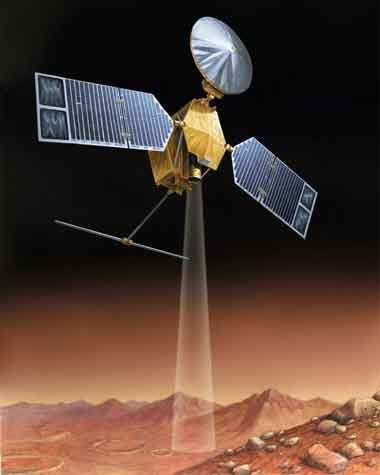Finds 'Vast' Amounts Of Water Ice At Lower Latitudes Than
Before
NASA's Mars Reconnaissance Orbiter has revealed vast Martian
glaciers of water ice under protective blankets of rocky debris at
much lower latitudes than any ice previously identified on the Red
Planet.

Scientists analyzed data from the spacecraft's
ground-penetrating radar and report in the November 21 issue of the
journal Science that buried glaciers extend for dozens of
miles from edges of mountains or cliffs. A layer of rocky debris
blanketing the ice may have preserved the underground glaciers as
remnants from an ice sheet that covered middle latitudes during a
past ice age. This discovery is similar to massive ice glaciers
that have been detected under rocky coverings in Antarctica.
"Altogether, these glaciers almost certainly represent the
largest reservoir of water ice on Mars that is not in the polar
caps," said John W. Holt of the University of Texas at Austin, who
is lead author of the report. "Just one of the features we examined
is three times larger than the city of Los Angeles and up to
one-half-mile thick. And there are many more. In addition to their
scientific value, they could be a source of water to support future
exploration of Mars."
Scientists have been puzzled by what are known as aprons –
gently sloping areas containing rocky deposits at the bases of
taller geographical features -- since NASA's Viking orbiters first
observed them on the Martian surface in the 1970s. One theory has
been that the aprons are flows of rocky debris lubricated by a
small amount of ice. Now, the shallow radar instrument on the Mars
Reconnaissance Orbiter has provided scientists an answer to this
Martian puzzle.
"These results are the smoking gun pointing to the presence of
large amounts of water ice at these latitudes," said Ali
Safaeinili, a shallow-radar instruments team member with NASA's Jet
Propulsion Laboratory, Pasadena, CA.
 Radar echoes received by the
spacecraft indicated radio waves pass through the aprons and
reflect off a deeper surface below without significant loss in
strength. That is expected if the apron areas are composed of thick
ice under a relatively thin covering. The radar does not detect
reflections from the interior of these deposits as would occur if
they contained significant rock debris. The apparent velocity of
radio waves passing through the apron is consistent with a
composition of water ice.
Radar echoes received by the
spacecraft indicated radio waves pass through the aprons and
reflect off a deeper surface below without significant loss in
strength. That is expected if the apron areas are composed of thick
ice under a relatively thin covering. The radar does not detect
reflections from the interior of these deposits as would occur if
they contained significant rock debris. The apparent velocity of
radio waves passing through the apron is consistent with a
composition of water ice.
Scientists developed the shallow radar instrument for the
orbiter to examine these mid-latitude geographical features and
layered deposits at the Martian poles. The Italian Space Agency
provided the instrument.
"We developed the instrument so it could operate on this kind of
terrain," said Roberto Seu, leader of the instrument science team
at the University of Rome La Sapienza in Italy. "It is now a
priority to observe other examples of these aprons to determine
whether they are also ice."
Holt and 11 co-authors report the buried glaciers lie in the
Hellas Basin region of Mars' southern hemisphere. The radar also
has detected similar-appearing aprons extending from cliffs in the
northern hemisphere. The rocky debris blanket topping the glaciers
apparently has protected the ice from vaporizing, which would
happen if it were exposed to the atmosphere at these latitudes.
 ANN's Daily Aero-Linx (05.02.24)
ANN's Daily Aero-Linx (05.02.24) ANN's Daily Aero-Term (05.02.24): Touchdown Zone Lighting
ANN's Daily Aero-Term (05.02.24): Touchdown Zone Lighting Aero-News: Quote of the Day (05.02.24)
Aero-News: Quote of the Day (05.02.24) ANN FAQ: Contributing To Aero-TV
ANN FAQ: Contributing To Aero-TV NTSB Final Report: Cirrus Design Corp SR20
NTSB Final Report: Cirrus Design Corp SR20




